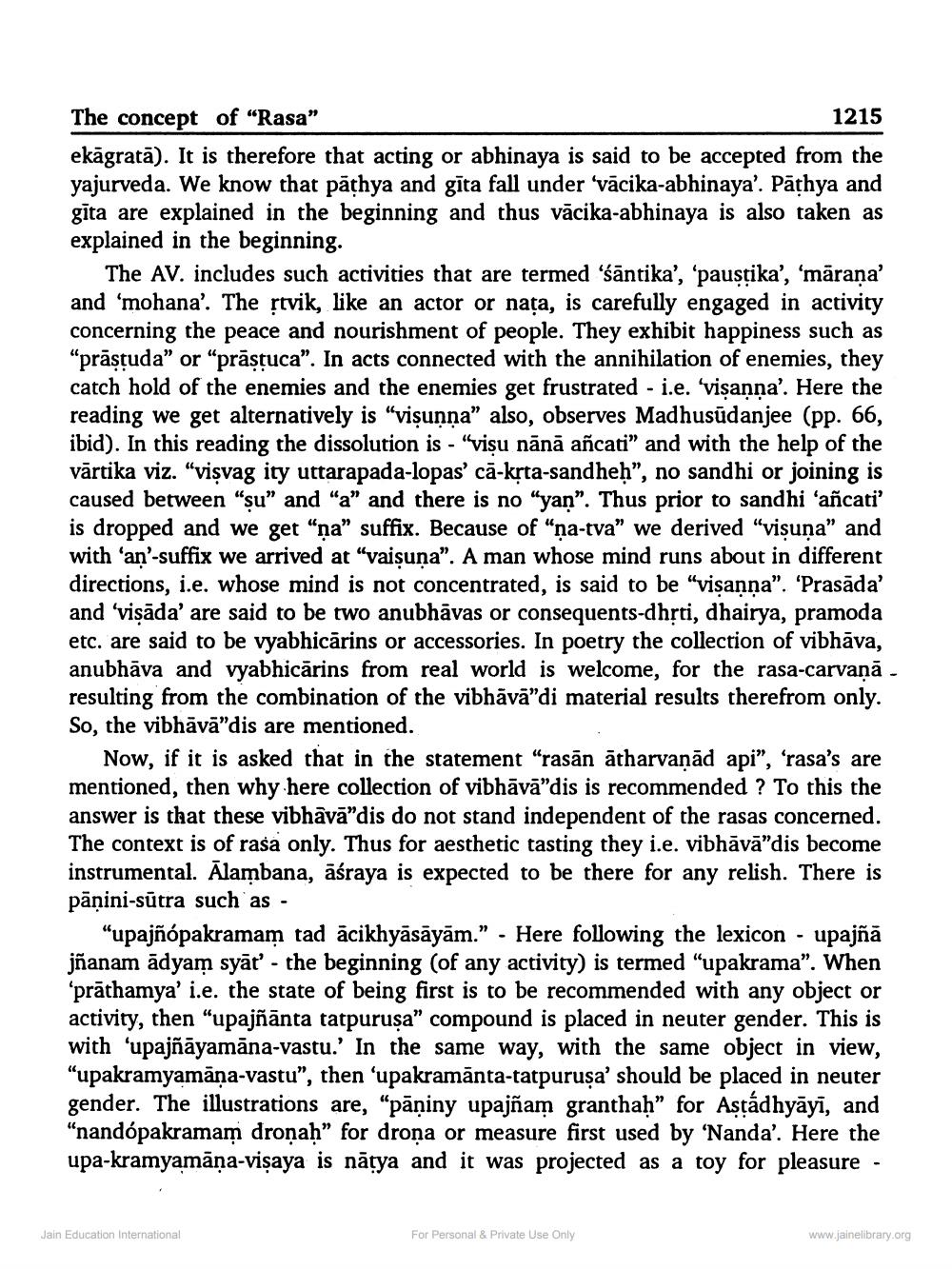________________
The concept of "Rasa"
1215
ekāgratā). It is therefore that acting or abhinaya is said to be accepted from the yajurveda. We know that pathya and gīta fall under 'vācika-abhinaya'. Pāṭhya and gīta are explained in the beginning and thus vācika-abhinaya is also taken as explained in the beginning.
The AV. includes such activities that are termed 'santika', 'paustika', 'māraṇa' and 'mohana'. The ṛtvik, like an actor or nata, is carefully engaged in activity concerning the peace and nourishment of people. They exhibit happiness such as "prāṣṭuda" or "prastuca". In acts connected with the annihilation of enemies, they catch hold of the enemies and the enemies get frustrated - i.e. 'viṣaṇna'. Here the reading we get alternatively is "visunna" also, observes Madhusudanjee (pp. 66, ibid). In this reading the dissolution is - "viṣu nānā añcati” and with the help of the vārtika viz. "viṣvag ity uttarapada-lopas' cā-kṛta-sandheḥ”, no sandhi or joining is caused between "şu" and "a" and there is no "yan". Thus prior to sandhi 'añcati' is dropped and we get "na" suffix. Because of "na-tva" we derived "viṣuna" and with 'an'-suffix we arrived at "vaiṣuna". A man whose mind runs about in different directions, i.e. whose mind is not concentrated, is said to be "viṣanna". "Prasāda' and 'viṣāda' are said to be two anubhāvas or consequents-dhṛti, dhairya, pramoda etc. are said to be vyabhicārins or accessories. In poetry the collection of vibhāva, anubhava and vyabhicārins from real world is welcome, for the rasa-carvaṇā resulting from the combination of the vibhāvā❞di material results therefrom only. So, the vibhāvā"dis are mentioned.
Now, if it is asked that in the statement "rasan atharvaṇād api", 'rasa's are mentioned, then why here collection of vibhāvā"dis is recommended? To this the answer is that these vibhāvā"dis do not stand independent of the rasas concerned. The context is of rasa only. Thus for aesthetic tasting they i.e. vibhāvā"dis become instrumental. Ālambana, āśraya is expected to be there for any relish. There is pāṇini-sūtra such as -
"upajñópakramam tad ācikhyāsāyām." - Here following the lexicon - upajñā jñanam ādyam syat' - the beginning (of any activity) is termed "upakrama". When 'prāthamya' i.e. the state of being first is to be recommended with any object or activity, then "upajñānta tatpurușa" compound is placed in neuter gender. This is with 'upajñāyamana-vastu.' In the same way, with the same object in view, "upakramyamāṇa-vastu", then 'upakramānta-tatpurușa' should be placed in neuter gender. The illustrations are, “pāņiny upajñam granthaḥ" for Astádhyāyī, and "nandópakramam dronah" for drona or measure first used by 'Nanda'. Here the upa-kramyamāṇa-viṣaya is nātya and it was projected as a toy for pleasure -
Jain Education International
For Personal & Private Use Only
www.jainelibrary.org




